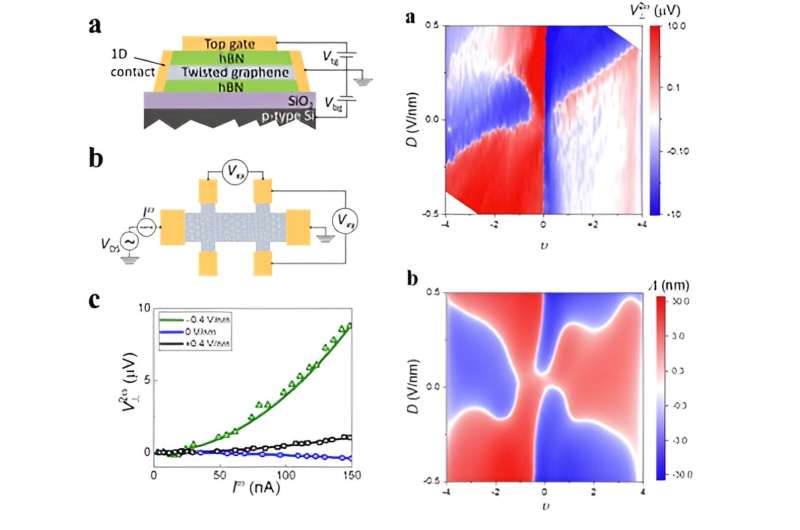This article has been reviewed according to Science X's editorial process and policies. Editors have highlighted the following attributes while ensuring the content's credibility:
fact-checked
peer-reviewed publication
trusted source
proofread
Physicists unlock controllable nonlinear Hall effect in twisted bilayer graphene

A team of international researchers led by The University of Hong Kong (HKU) and The University of Science and Technology (HKUST) has made a significant discovery in the field of quantum materials, uncovering the controllable nonlinear Hall effect in twisted bilayer graphene.
The findings, published in Physical Review Letters, shed new light on the unique properties of two-dimensional quantum moiré materials and hold promise for a wide range of applications in industries such as new materials and quantum information to achieve terahertz detection with ultra-high sensitivity at room temperature.
The team, composed of Ph.D. student Xu Zhang and his advisor Dr. Zi Yang Meng from the Department of Physics at HKU; Professor Ning Wang from the Department of Physics at HKUST and his postdoctoral researchers Meizhen Huang and Zefei Wu (currently an Associate Researcher at the University of Manchester); as well as Professor Kai Sun from The University of Michigan, conducted in-depth research using a combination of theory, computation, and experiments.
They discovered that by adjusting the dispersion of the topological flat bands in twisted bilayer graphene, the Berry curvature dipole moments, which play a crucial role in the Hall effect (details can be found in the Supplementary Note), can be easily controlled and manipulated.
Using a vertically applied electric field, the researchers found the dispersion of the flat bands in twisted graphene can be easily tuned and observed a clear nonlinear voltage response in the longitudinal direction when a transverse driving current was applied. The response varied significantly with the adjustment of the applied field, strain and twist angles, exhibiting increases, decreases, and changes in direction.
These experimental observations confirmed the sensitivity of the nonlinear transport behavior to the sliding of the Berry curvature hotspots in the topological flat bands, perfectly explained by their theoretical calculations.
The researchers also investigated the role of the moiré potential and twist angle in the controllable nonlinear Hall effect of twisted bilayer graphene. They found that the strength of the moiré potential played a crucial role in determining the magnitude of the observed nonlinear response. By varying the twist angle between the layers of graphene, the researchers were able to manipulate the moiré potential and consequently control the nonlinear transport behavior.
The controllable nonlinear Hall effect demonstrated in twisted bilayer graphene holds great potential for the realization of quantum Hall materials and nonlinear Hall effects in new experimental platforms. Unlike traditional electronic devices, the nonlinear Hall effect in graphene, driven by low-frequency currents, does not have voltage threshold or transition time limitations. This opens up possibilities for applications in frequency multiplication and rectification using low-frequency currents, especially in the terahertz frequency range with significant response and ultra-high sensitivity at room temperature.
This discovery of the controllable nonlinear Hall effect in twisted bilayer graphene represents a significant advancement in the field of quantum materials. It paves the way for further exploration and applications in condensed matter physics, new materials, and quantum information.
More information: Meizhen Huang et al, Intrinsic Nonlinear Hall Effect and Gate-Switchable Berry Curvature Sliding in Twisted Bilayer Graphene, Physical Review Letters (2023). DOI: 10.1103/PhysRevLett.131.066301
Journal information: Physical Review Letters
Provided by The University of Hong Kong





















